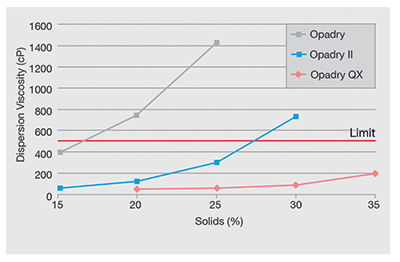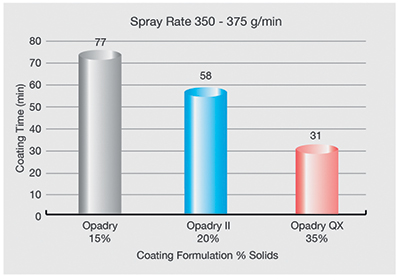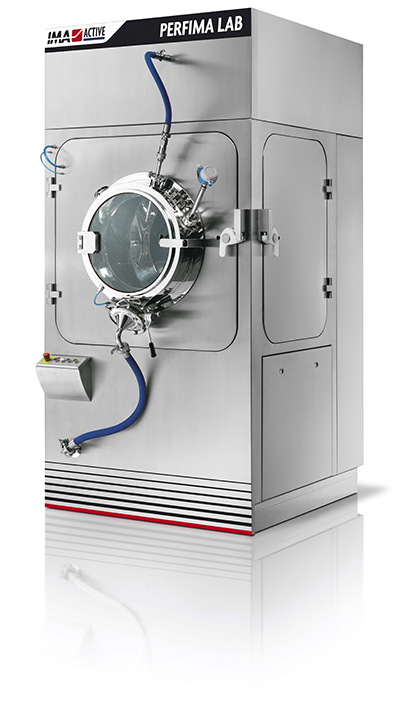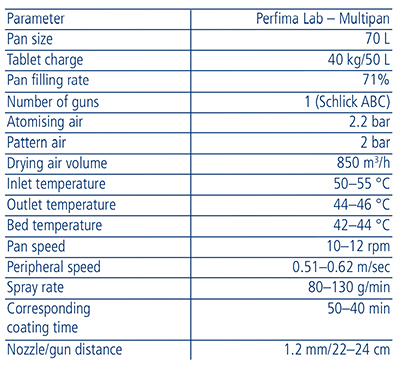In April 2016, Colorcon, a world leader in the development, supply and technical support of specialty excipients, announced an innovative breakthrough for pharmaceutical tablet coating.
Opadry QX for quick and flexible coating is setting new productivity, efficiency and appearance standards for coated tablets. This advanced formulation greatly reduces preparation and production time, ensuring coating process efficiency and cost reductions in all types of equipment, from traditional pans to continuous coating equipment.
The system can be applied across a broad range of process conditions, enabling even those containing temperature-sensitive active pharmaceutical ingredients to be successfully coated, resulting in a premium quality finish for tablets.
Opadry QX is a low viscosity formulation that is dispersed in water and ready for use in less than 25 minutes — significantly cutting preparation time. Even at high solids levels of up to 35% w/w, the viscosity of the formulation remains low, allowing faster spray rates to help achieve greater productivity for each coating run (Figure 1).

Figure 1: Opadry QX viscosity below reccomended level
Using Opadry QX at the typical 3% weight gain level, coating uniformity is achieved significantly faster compared with alternative systems (Figure 2). This improved processing also means tablets are exposed for far less time to the tumbling, heat and moisture associated with the coating process.

Figure 2: Film coating comparison, 48” coating plan
Manufacturing Chemist’s Dr Kevin Robinson spoke to Deborah to find out more.
Why did you decide to develop this new film coating system?
Deborah Taylor: For more than 45 years, Colorcon has been developing Opadry systems that address the essentials of film coating, while continuing to provide innovative formulations to optimise process time while delivering an exceptional finish. For immediate release applications, these include the use of colour for branding and differentiation, aesthetics and taste-masking, along with light, environmental and moisture protection. Colorcon is always reassessing the evolving requirements of pharmaceutical and nutritional producers, and addressing unmet needs. The current market focus is on continuous manufacturing and developments associated with batch consistency and manufacturing process improvements. Colorcon’s goal was to develop an innovative, fully formulated system that was suitable for fast application and scalable across a range of coating equipment, while still delivering colour uniformity and a high-quality finish.

The IMA 8200 Active Perfima Lab
What are the benefits for pharmaceutical companies?
DT: In addition to the manufacturing efficiencies and subsequent cost reductions, Opadry QX enables trouble-free scalability from the formulation laboratory to large production equipment. All Opadry systems are formulated using high-quality materials designed to meet global compendial requirements and are available in a wide range of colour options, matched to end customer requirements. Owing to the complexity of pharmaceutical regulations worldwide, Colorcon applies its years of formulation expertise to deliver a system for the local market to meet the customer’s specific goal. All ingredients used in Opadry QX, as with all our film coatings, come from accredited sources supported through a global business continuity programme (BCP). As a result, no supply chain interruptions are experienced by the user. Regulatory filing information packages are also available from Colorcon, making the customer’s application process that much easier.
What about for continuous manufacturing?
DT: As the industry seriously considers a transition from batch to continuous manufacturing, there is a need for coatings that are compatible with continuous processes operating at higher speeds, without compromising final tablet appearance. Opadry QX was developed as a coating that can be sprayed much faster, with higher levels of solids in the coating dispersion, which significantly increases productivity while still delivering the perfect finish.
Are some pharmaceutical companies already using this new system?
DT: There are a significant number of products in active development; obviously, details of the customers’ projects are confidential. Opadry QX has created a great deal of attention from both innovator and generic companies, as the scalability and speed of application are very attractive, as well as the perfect finish.
Case study: process performance on IMA perforated coaters
With the aim of testing Opadry QX performance on IMA equipment, a series of tests was performed on the company’s perforated coaters. Tests were run on both pilot- and production-scale coaters to demonstrate the good scale-up properties of the new formulation. Round-shaped placebo tablets (spray dried lactose [60%], Avicel pH 102 [39%], magnesium stearate [1%]) with a mean weight of 280 mg, a mean diameter of 9 mm and a mean crushing strength of 90 N were used as substrates for all the trials.
Initial tests on the Perfima Lab 70 L drum were performed with a batch size of 40 kg of placebo tablets, which represents 70% of the maximum drum volume. A 4% weight gain was applied by using Opadry QX prepared at 30% in water (total dispersion applied 5330 g). The test parameters are reported in Table I.

Table I: Test parameters for the Perfima Lab 70 L drum
The best combination of good coating quality and minimum process time was found with a trio of tests leading to a 40 minute coating time. Using a 70% filling volume and the same tablet characteristics, the process was then scaled-up to a production coater, providing a pan volume of 250 L. The tablet temperature was similar to the pilot tests and, as a consequence, the outlet air was maintained in a comparable range. Peripheral speed was kept similar at 0.55 m/sec. The number of nozzles was increased from one to four, so inlet air volume and spray rate were multiplied by four to maintain similar wetting conditions. This required a small adjustment in the gun distance and atomisation pressure (Table II).

Table II: Test parameters for the Perfima 250 L drum
Two tests were enough to successfully scale-up the process and achieve perfect final coating quality.
Based on these trials, we conclude that a combination of the low viscosity Opadry QX formulation, together with the high-performance coater, even when sprayed at a high delivery rate, delivers an effective tablet coating solution that falls well within the operational process parameters of both IMA pilot and production coaters. This provides an easy scale-up procedure and ensures very short coating times compared with other coating formulations.




